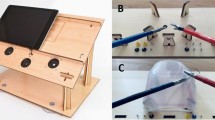Abstract
The aim of this study was to evaluate whether a training programme involving an assessment exercise performed on a laparoscopic trainer model leads to an improvement in the acquisition of laparoscopic skills in surgical trainees. Subjects were recruited from a cross-section of surgical trainees at the Great Ormond Street Hospital, Department of Surgery and the Institute of Child Health. All subjects completed both a baseline laparoscopic surgical skills questionnaire and three exercises on a new laparoscopic trainer model. Thirteen subjects completed both the baseline questionnaire and all three assessment exercises. These subjects exhibited a wide range of previous experience in laparoscopic surgery. Sixty-nine percent of subjects showed a significant improvement in the assessment exercise score with training (ANOVA; P = 0.01). Sixty-two percent of subjects showed a greater improvement between exercises 2 and 3 than between exercises 1 and 2. The difference in score between exercises 1 and 2 was not statistically significant (P = 0.597), whereas the difference in score between both exercises 2 and 3 and exercises 1 and 3 was statistically significant (P = 0.018 and P = 0.005, respectively). The double glove training model is thus a simple, inexpensive, and easily reproducible tool that elicits a significant improvement in laparoscopic surgical skills in surgical trainees with a broad range of previous laparoscopic experience. It can therefore be used as part of a training programme to facilitate the acquisition of laparoscopic skills in a paediatric surgery setting.





Similar content being viewed by others
References
Skidmore FD (1997) Junior surgeons are becoming deskilled as result of Calman proposals. BMJ 314(7089):1281
Ross DG, Harris CA, Jones DJ (2002) A comparison of operative experience for basic surgical trainee in 1992 and 2000. Br J Surg 89(Suppl 1):60
Moorthy K, Munz Y, Sarker SK, et al (2003) Objective assessment of technical skills in surgery. BMJ 327(7422):1032–1037
MacDonald R (2003) Update on modernising medical careers. BMJ 327(7416):s89–s90
Issenberg SB, McGaghie WC, Hart IR, et al (1999) Simulation technology for health care professional skills training and assessment. JAMA 282(9):861–866
Madan AK, Frantzides CT, Park WC, et al (2005) Predicting baseline laparoscopic surgery skills. Surg Endosc 19(1):101–104
Hoznek A, Katz R, Gettman M, et al (2003) Laparoscopic and robotic surgical training in urology. Curr Urol Rep 4(2):130–137
Lossing AG, Hatswell EM, Gilas T, et al (1992) A technical-skills course for 1st-year residents in general surgery: a descriptive study. Can J Surg 35(5):536–540
Rowan AN (1993) Is justification of animal research necessary? JAMA 269:1113–1114
Anastakis DJ, Regehr G, Reznick RK, et al (1999) Assessment of technical skills transfer from the bench training model to the human model. Am J Surg 177(2):167–170
Barnes RW, Lang NP, Whiteside MF (1989) Halstedian technique revisited. Innovations in teaching surgical skills. Ann Surg 210(1):118–121
Reznick RK (1999) Virtual reality surgical simulators: feasible but valid? J Am Coll Surg 189(1):127–128
Derossis AM, Fried GM, Abrahamowicz M, et al (1998) Development of a model for training and evaluation of laparoscopic skills. Am J Surg 175(6):482–487
Scott DJ, Bergen PC, Rege RV, et al (2000) Laparoscopic training on bench models: better and more cost effective than operating room experience? J Am Coll Surg 191(3):272–283
Jones DB, Brewer JD, Soper NJ (1996) The influence of three-dimensional video systems on laparoscopic task performance. Surg Laparosc Endosc 6(3):191–197
Wolfe BM, Szabo Z, Moran, et al (1993) Training for minimally invasive surgery: need for surgical skills. Surg Endosc 7:93–95
Melvin WS, Johnson JA, Ellison EC (1996) Laparoscopic skills enhancement. Am J Surg 172:377–379
Dent TL (1992) Training, credentialing, and evaluation in laparoscopic surgery. Surg Clin North Am 72:1003–1030
Dagash H, Chowdhury M, Pierro A (2003) When can I be proficient in laparoscopic surgery? A systematic review of the evidence. J Pediatr Surg 38(5):720–724
Nataraja RM, Ade-Ajayi N, Curry JI (2006) Pilot study of new training model for laparoscopic surgery. Pediatr Surg Int 22(6):546–550
Kumar BD, Munz Y, Moorthy K, et al (2003) How can a handful of water assess basic laparoscopic skills? Ann R Coll Surg Engl 85:426–427
Grantcharov TP, Bardram L, Funch-Jensen P, et al (2003) Learning curves and impact of previous operative experience on performance on a virtual reality simulator to test laparoscopic surgical skills. Am J Surg 185(2):146–149
Van Rij AM, McDonald JR, Pettigrew RA, et al (1995) Cusum as an aid to early assessment of the surgical trainee. Br J Surg 82(11):1500–1503
MacDonald J, Williams RG, Rogers DA (2003) Self-assessment in simulation-based surgical skills training. Am J Surg 185(4):319–322
Evans AW, Aghabeigi B, Leeson R, et al (2002) Are we really as good as we think we are? Ann R Coll Surg Engl 84(1):54–56
Powers TW, Murayama KM, Toyama M, et al (2002) Housestaff performance is improved by participation in a laparoscopic skills curriculum. Am J Surg 184(6):626–630
Traxer O, Gettman MT, Napper CA, et al (2001) The impact of intense laparoscopic skills training on the operative performance of urology residents. J Urol 166(5):1658–1661
Scott DJ, Young WN, Tesfay ST, et al (2001) Laparoscopic skills training. Am J Surg 182(2):137–142
Author information
Authors and Affiliations
Corresponding author
Appendix: Laparoscopic experience self-assessment questionnaire
Rights and permissions
About this article
Cite this article
Nataraja, R.M., Ade-Ajayi, N. & Curry, J.I. Surgical skills training in the laparoscopic era: the use of a helping hand. Pediatr Surg Int 22, 1015–1020 (2006). https://doi.org/10.1007/s00383-006-1746-0
Accepted:
Published:
Issue Date:
DOI: https://doi.org/10.1007/s00383-006-1746-0




